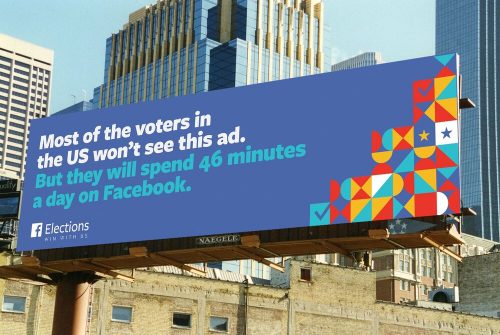How to Increase Sales through Facebook Ads for Your Business. As you may already know, Facebook originally began as a Social Media platform for college students. Well, more specifically, Harvard students. But boy oh boy has the game changed! This social media platform has quickly adapted to the evolving trends and has maximized on its capital potential. The Facebook team has created innovative ways to remain one of the most essential platforms known today. This platform is one of the most effective and influential platforms for both small and large businesses to expand their consumer market. And that’s simply because Facebook is the world’s largest social market.
Don’t be misled by Facebook’s origins. Facebook was way on top of their marketing game for over a decade. At this point, it’s hard to underestimate the power and drive behind Facebook. Though its main agenda was to expand one’s social network in University in 2004, by 2007 Facebook opened their Marketplace. According to Brandwatch, “By the end of 2007 over 100,000 companies had signed up, with Facebook launching Pages for Businesses to support this. Already they’re building on existing ad revenue to make advertisement on the platform accessible to even the smallest of businesses.” So, whether you’re selling handmade shoes in your local Sunday market or you’re Apple, you will benefit from taking advantage of Facebook’s advertising platform.

Photo Credit by Marietje Schaake
Let’s explore all the potential assets Facebook can offer your business, and why Facebook advertisements are an absolute game changer.
In this article we’ll guide you through the Facebook labyrinth, beyond sending your High School friends a lurking friend request or, scrolling through a feed of friends of friends’ babyshoots. Instead we’ll focus on how Facebook ads will attract the exact audience interested in buying your products. As a business owner, could you ask for anything more? Okay, we can imagine a few more things to ask for, but let’s not get too nit-picky here.
How effective are Facebook Ads?
When considering the digital strategy of your business, you will want to utilize the most up-to-date tools available. You want to employ a platform with a large and wide audience, and boy does Facebook have exactly that! According to Word Stream, “Facebook has a global audience of approximately 1.5 BILLION people – around one-fifth of the entire planet’s population, give or take a few hundred million.” Talk about a market! It’s not that you want to splash your advertisement across 1.5 billion people, because that’s not exactly budget friendly, but try and imagine what kind of database Facebook has collected over the years. They might know more about us then we know about ourselves!
What makes Facebook advertising so effective is not only the amount of users the platform has, which is undeniably impressive, but how Facebook collects and organizes its user data. First their systemized data is delivered to marketers. Then the marketers can use that information to target the exact audience likely to purchase your product. So long billboards on highways, hello target audience scrolling through Facebook in the comfort of their own home! In 2014, according to Facebook, “More than 30 million businesses have active Pages,” on their platform. It’s hard to imagine what their numbers are like now, almost seven years later! Let’s dive a little deeper into how Facebook ads reach a target audience, shall we?
How do Facebook ads reach a target audience?
The most effective way to use Facebook ads is by utilizing what’s called their ‘Microtargeting feature.’ The way microtargeting works is by developing an understanding of your niche audience. Once the target audience has been analyzed and tested, microtargeting will deliver the message to your target audience in a way that appeals to their interests and needs. Naturally, the main goal of your advertisement is the conversion of leads. Rather than splashing your advertisements across thousands of Facebook pages, Microtargeting aids in targeting an audience through:
- Demographics- age, gender, etc.
- Location
- Behavioral Patterns- their shopping patterns and offline interests
- Interest- whether someone loves gardening, clothing, gadgets, cooking, etc.
Microtargeting through Facebook ads is advantageous because, let’s say you are a company who designs maternity wear.
If your advertisements are placed before a group of 19 year old boys, or 65 year old men, we can’t imagine gaining many leads from such an audience. Now let’s imagine you’re running a small or large surfboard company, right? And your advertisements appear on the Facebook page of college students who live in Long Beach, California. You will very likely capture your audience’s attention and experience a favorable increase in sales. Especially, when compared to the former example of maternity wear!
Some marketers warn against targeting a very specific niche audience. You want to capitalize on the audience you already have, but you also want to expand your network. You don’t want to end up overthinking your target audience and then reducing your reach more than necessary. So, let’s say you believe your target audience is 20-30 year olds. Rather than limiting yourself to this age range, you can increase your range from 20-40. And finally, setting up a realistic daily budget for your ads can go a long way.
Is it Difficult to Generate Facebook Ads?
Before even considering Facebook ads, you need to set up a Facebook business page. This way you place your business on the map, so to speak. Here are the basic steps for setting yourself up for a promising future:
- Through your Facebook business page is where you’ll head on over to Facebook ads Manager.
- From there you’ll need to click on Create a Campaign.
- The next step is deciding what your marketing objective is in order to steer Facebook ads onto the correct audience.
- You’ll have eleven marketing campaigns to choose from. You can choose to use the location to get the locals to your bricks-and-mortar stores. You can choose to drive more traffic to your website, app, videos, events or sales. That all depends on what you’re looking for. Remember* to have your goals set up before venturing into Facebook ads.
- Then you’ll need to name that campaign and set up your Ad Account, if you haven’t already.
- Once you have that set up you begin to manage your target audience. There are no secrets on this end. Facebook will provide you with the audience size for each option. This way you know you’re hitting optimal results. Detailed targeting allows you to get as specific as possible, if you know exactly who your potential consumers are.
- Afterwards, you’ll need to settle on your Facebook ad placement. Placement can be anywhere from the device type to Facebook feeds, Instagram or articles.
- And finally, you’re ready to design your Facebook ad!
Our Tips for Running Facebook Ads
- Start small- not necessarily budget wise, but with how many categories you tick for your target audience.
- Facebook Pixel- you may be overwhelmed by all the options Facebook offers. Some of the advanced options are best when used later on. After you get a hang of how to use Facebook Ads to your best advantage. However, Facebook Pixel is not something you should skip out on. Facebook Pixel helps you track conversions. This way you can remarket to an audience who has clicked on your product and later generate ads to your lookalike audience. This will only increase the value on your ad costs.
- Don’t rework the settings on your ads- altering the settings on your Facebook ads while they are running will set back the Facebook algorithm.
- Run several ads with an alternating budget to see what works best for your business
How Often Should I Generate Facebook Ads?
We recommend starting off with multiple test ads before settling on how often you should create new ads on Facebook. Launch a few ads and watch it carefully for the next 4-6 days. Of course the budget you set will affect the ad results. So, we recommend running a test-run with the budget you expect to use throughout the year. Facebook offers what’s called an A/B Significance Test, which we highly recommend taking advantage of. Rather than deciding for yourself which of your test ads has proven most effective, Facebook will calculate for you which ads had the highest results. You will see both Visitors/Clicks and Conversions. Split testing is a reliable method for calculating which formulas have worked and which were less cost effective.
The final goal of your ad campaign will determine the optimal lifespan of your ad. With that in mind, it is recommended to revamp your ads for a number of reasons. If your ads are lingering on your target audiences’ page for too long they will soon grow, let’s say, ‘immune’ to your ads. When the same ads appear day after day they become background noise. When this happens, your target audience will scroll right past your ad without so much as a glance. AgoraPulse refers to such a consequence as either Ad Fatigue, or Ad Blindness. Over saturating your audience with ads can cheapen it’s appeal to your audience over time.
Try running ads for two weeks long and then changing up the images, texts, format and design. This way your ads won’t grow stale on it’s audience. By trying a variety of designs and approaches you will quickly learn what’s effective and which formulas are fruitless. The idea is to pay attention to the data you collect over the next few months in order to understand the best approach. Makes sense right?
The data to lookout for:
- Your click-through-rate: how often your audience clicks on your ads and follows the ad to your website, event, product or channel.
- Frequency: how often your ad has been displayed to your target audience (remember, to often will exhaust and blind your target audience)
- Negative Feedback: the number of your target audience who has hidden posts from your page (yikes!)
How to Increase Your Audience with Facebook Ads
Once you’ve learned how to build your first few ads and have run a couple of tests, then you’re ready to increase your Facebook Ad reach. Ads often take a few days to start picking up clicks and conversions. But as we mentioned earlier, you want to avoid say, boring, your audience. This means your advertisement only has a number of days to truly make an impact. So how do you get the biggest bang for your buck? Or in this case, click for your cucumber?
To maximize leads you should:
- Make sure you have the best copy possible
- Always use high quality images
- Don’t invest more money than you have in your Facebook Ads
- Follow Facebook’s advice, calculations, and ‘look-alike’ audience
- Narrow your target audience to those who will respond to your campaign for high relevance and higher impressions
Many marketers believe that it isn’t about how many Facebook users view your ad, but who scrolls past your ad. A 30 year-old in Buenos Aires isn’t going to respond to your rooftop urban farming advertisement when it’s the dead of winter in the Southern Hemisphere. And they certainly won’t respond to the ad when it’s set to English and they are fluent in Spanish and Portugese. Too true. But, how about advertising your modernist furniture to a user who Facebook knows has been searching for a new house? Then you can rest assured that you will not only see click-throughs, but a steady increase in sales.
Mistakes to Avoid when Commissioning your Facebook ads
We’re going to assume at this point that you’re new to Facebook ads. Otherwise, why else would you be here? We want you to avoid common mistakes made by newbies. Here are some of the most common mistakes and how to avoid making them yourself.
- The Ad Format you’ve selected isn’t suitable for your product or target audience– as we’ve mentioned earlier, it’s important to set up test ads first in order to discern what works and what doesn’t. Try different formats and analyze which generates the best results. You can opt for video ads, higher quality photos, or simply use strong copy to grab your audience’s attention. But make sure not to run an ad campaign for too long. The results are often disappointing.
- Your target audience is too wide– we can’t stress this enough. It’s essential to narrow down your target audience, especially in the beginning. It may seem logical, the more people who see your ad, the higher the chances are of scoring a lead. It’s been proven not to produce the best results. Even if this would be true, you may end up maxing out on your budget before you’ve had time to understand your audience. As the school-teacher saying goes, ‘it’s quality not quantity.’
- Your Copy is not promoting a call-to-action (CTA)– It’s important not to have too much text in your advertisement. Because, well, most of your consumers don’t actually want to read that much. Unless of course it’s a post by their favorite musician, like who knows? Bob Dylan? Keep it short and sweet. And don’t forget, your ad is simply there to capture a click, not a purchase. Like with fishing, you’ve got to spend a lot of time pre-fishing in order to make it to the big fish.
To find out more about mistakes you may be making when it comes to Facebook ads, check out this Forbes article on,10 Mistakes Newbies Make with Paid Facebook Ads.
You might be stressed about your text and word count from this list. As a general rule of thumb Hootsuite has come up with a invaluable strategy for word count:
Image ads
- Headline: 25 characters
- Link description: 30 characters
- Body text: 125 characters
- Campaign objectives: All except video views
Video ads
- Headline: 25 characters
- Link description: 30 characters
- Body text: 125 characters
- Campaign objectives: All except catalog sales
Facebook Stories ads
- Text: No set character count. Aim to leave 250 pixels text-free at the top and bottom of the ad.
- Campaign objectives: Engagement, messages, catalog sales, store traffic
Final Thoughts on Facebook Ads
According to Pew Research Center in 2019, “Facebook – which recently celebrated its 15th anniversary – remains one of the most widely used social media sites among adults in the U.S.” This only stands as a confirmation that the highest consumer market remains present on Facebook. When starting off with Facebook advertisement, you want to take a simple yet educated approach. There are an overwhelming number of options on how to generate advertisements on this platform, that may appear confusing to a newbie.
If you have the time to learn how to effectively generate ads and follow the success rates of your advertisements, then we recommend going for it! Diving into Facebook advertisements is a learning process. If the wide range of ad options are too overwhelming for you, there are incredible services which can take the reins while you sit back and run your business. While you may know the ins and outs of running a storefront, running Facebook ads is a whole other world! We don’t want to discourage you from learning something new and taking on new challenges. But we do want you to be prepared for the challenge you’re about to take on. Because like the great Roman Philosopher, Lucius Annaeus Seneca once said, ““Difficulties strengthen the mind, as labor does the body.” Let’s choose our battles, but choose them wisely!
Other posts you might like to read:
- What is SEO and Why Does It Matter?
- What is Content Marketing and Why Does It Matter?
- 30 Digital Advertising Statistics for Businesses
References Summary:
- (Joshua Boyd, 2019) The History of Facebook: From BASIC to Global Giant https://www.brandwatch.com/blog/history-of-facebook/
- (Dan Shewan, 2020) Does Facebook Advertising Work? [DATA] https://www.wordstream.com/blog/ws/2016/01/25/does-facebook-advertising-work
- (Facebook, 2014) The Getting Started Series: How Facebook Ads Work https://www.facebook.com/business/news/How-Facebook-Ads-Work
- (Brooke B. Sellas, 2020) How Long Should You Let Your Facebook Ads Run? https://www.agorapulse.com/blog/facebook-ad-campaign-run/
- (Sujan Patel, 2017) 10 Mistakes Newbies Make with Paid Facebook Ads https://www.forbes.com/sites/sujanpatel/2017/02/04/10-mistakes-newbies-make-with-paid-facebook-ads/
- (Christina Newberry, 2020) How to Advertise on Facebook in 2020: The Definitive Facebook Ads Guide https://blog.hootsuite.com/how-to-advertise-on-facebook/#tips
- (ANDREW PERRIN AND MONICA ANDERSON, 2019) Share of U.S. adults using social media, including Facebook, is mostly unchanged since 2018 https://www.pewresearch.org/fact-tank/2019/04/10/share-of-u-s-adults-using-social-media-including-facebook-is-mostly-unchanged-since-2018/








